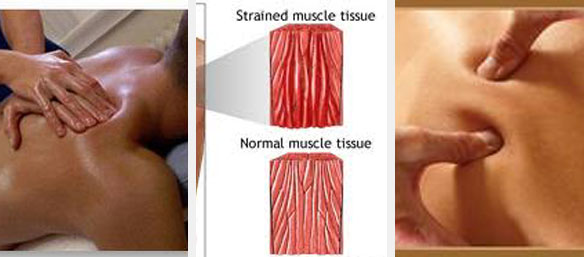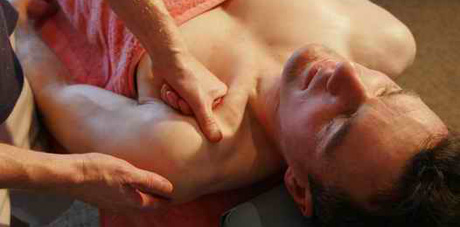What is Deep-Tissue Massage?
Deep-tissue massage is a specific type of massage therapy that concentrates on realigning deeper layers of muscles and connective tissue. By using deep finger pressure and slow, firm strokes, deep tissue massage is used to treat a variety of physical ailments. Many doctors recommend deep-tissue massage to their patients as a treatment option because of its benefits.
Because deep-tissue massage increases the flow of blood through through the body, it is especially helpful for chronically tense and contracted areas such as stiff necks, low back tightness, and sore shoulders.
Some of the same strokes are used as classic massage therapy, but the movement is slower and the pressure is deeper and concentrated on areas of tension and pain. Deep tissue massage techniques involve intensive application of pressure on your body and the therapist often uses his or her elbows, knuckles, forearms and hands to apply the right amount of pressure to touch the deeper muscle tissues. This action triggers circulation of blood and oxygen in your body, thereby, releasing toxins trapped underneath. Increased blood and oxygen circulation in the body promotes healing. Do not forget to drink lots of water, as it helps flush out the toxins released in the process.

How Does Deep Tissue-Massage Work?
As with a classic Swedish massage, you will be lying naked on a massage table and partially covered with a sheet or towel.
When there is chronic muscle tension or injury, there are usually adhesions (bands of painful, rigid tissue) in muscles, tendons, and ligaments.
Adhesions can block circulation and cause pain, limited movement, and inflammation.
Deep tissue massage works by physically breaking down these adhesions to relieve pain and restore normal movement. To do this, the massage therapist often uses direct deep pressure or friction applied across the grain of the muscles. The strokes used in Deep Tissue Massage are similar to those used in a Swedish Massage except more pressure is used and it uses cross grain strokes (strokes that go across the gain of the muscles instead of with the grain).
During Swedish massage, usually the therapist will only use their hand and forearm, however with a Deep Tissue Massage, elbows, fingers, and ceramic, wooden, or glass tools may be used for optimal penetration of the muscle. The speed of the strokes will be slower than a classic massage as well, which means they are longer in duration. The massage therapist will apply pressure on sore spots and hold it for a few minutes before moving on, for extra relief.
Some people think that if you just push hard enough, a knot could be worked out in one session, but this is not the case. For built-up tension and chronic knots (adhesions) deep tissue massage is just one part of the treatment. If you do not exercise, correct your posture, and/or employ relaxation techniques along with Deep-Tissue Massage you may not get the full benefits from your massage.
One of the most important things to remember to do when getting a Deep Tissue Massage is to breathe deeply during the session and while relaxing afterwards. Oxygenating the muscles will help the massage do its work and ease discomfort.

Will Deep-Tissue Massage Hurt?
At certain points during the massage, most people find there is usually some discomfort and pain due to the pressure applied.
It is important to tell the massage therapist when things hurt and if any soreness or pain you experience is outside your comfort range.
There is usually some stiffness or pain after a deep tissue massage, but it should subside within a day or so. The massage therapist may recommend applying ice to the area after the massage.
A good way to recover from a Deep Tissue Massage is by soaking in a warm bath with Epsom salt. This soaking is recommended because it will help get more of the toxins out of your body (Epsom salt draws the toxins out into the water). Your muscles need some rest after one of these massages, even if you feel no soreness. So do not plan any activities within a day of a Deep Tissue Massage.
Benefits of Deep-Tissue Massage
Improves Blood Pressure
Deep-tissue massage helps ease stress and tension, which can have a beneficial effect on blood pressure. People who had a deep-tissue massage saw their systolic pressure drop by an average of 10.4 mm Hg and their diastolic pressure drop an average 5.3 mm Hg, according to a study cited by the University of Maryland Medical Center. Deep-tissue massage can help increase the body’s production of serotonin, the hormone that promotes happiness and good feelings.
Breaks Up Scar Tissue
Over time, deep-tissue massage therapy can help break up and eventually erase scar tissue in the body. It does this by improving lymphatic circulation and drainage to improve flexibility and range of motion in the affected area. Scar tissue is often associated with ongoing pain and stiffness, so deep-tissue massage can improve these symptoms. Massage therapy is often recommended for people who are recovering from surgery.
Rehabilitates Injured Muscles
Deep-tissue massage can be an effective treatment for injured muscles. Because it facilitates the movement of toxins from the muscles and helps stretch tight or twisted muscle mass, deep-tissue massage can help promote healing. Because massage also helps relax muscles, it can reduce the pain caused by injuries, too. Deep-tissue massage is frequently used to rehabilitate sports injuries.

Conditions Treated with Deep-Tissue Massage
Unlike classic massage therapy, which is used for relaxation, deep tissue massage usually focuses on a specific problem, such as:

